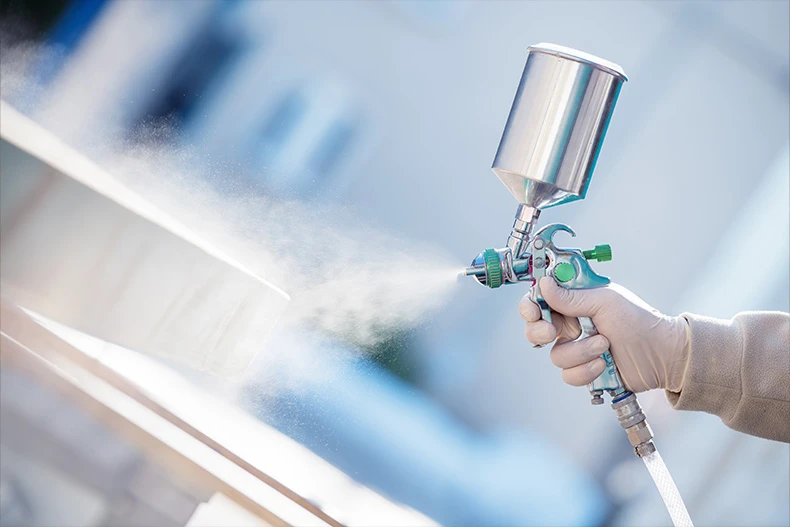Contact us
Industrial waste water is the polluted water generated by industrial processes. Depending on its source, it is contaminated with a wide variety of pollutants and must be treated before being discharged into public supply networks.
Industrial waste water is often used synonymously with industrial water, but this is not entirely correct.
Industrial water is the generic term for water used in industry during production and processing operations. This includes, for example, water for cleaning surfaces, for preparing rinses, acid treatments or active baths, and much more.
Industrial water - once it has served its purpose in production - becomes polluted industrial wastewater.
The composition of industrial water is not regulated - it depends on the requirements of the respective production and can be deionized water (fully demineralized/distilled water) or, for example, completely normal municipal water from the tap.
The composition of typical types of industrial wastewater cannot be generalized either. The composition of industrial waste water is as individual as the productions of the industry itself.
Contaminants in industrial water differ greatly depending on the source of a specific industrial waste water.

A lot of waste water is produced in paint shops that clean their parts before coating© AzmanL - iStock
Industrial wastewater is usually contaminated with pollutants, which can be classified as follows:
are contaminants that may be dissolved in water, such as salts or light liquids like oils that are not dissolved in water. Interfering substances in industrial wastewater also include grease, clay or sand.
are water pollutants from industry that can cause disease and other intense reactions in the human body. Microplastics, residues of pharmaceuticals and detergents and other synthetic organic substances, as well as viruses, bacteria and fungi, are characteristic for this type of industrial wastewater, as are poisons and heavy metals.
have, for example, residues of phosphorus and nitrogen compounds (fertilizers) from agriculture in their composition that lead to eutrophication when they enter stagnant waters. This means that the oversupply of nutrients can lead to excessive/harmful growth of various plant species (e.g. algae blooms).
are mostly biodegradable and produce an acrid odor during the anaerobic degradation process. Uric acid and glucose in water cause oxygen depletion, thereby reducing oxygen levels in water bodies. As a result, industrial water pollution threatens fish populations.
In general, polluted water usually consists of only a few percent of contaminants in dissolved and undissolved forms or as organic compounds. Therefore, it is worthwhile to reduce pollution through wastewater treatment systems in which the filtered, clean water can be reused in production.
The manufacturing industry requires huge amounts of water for a wide variety of production processes. In the course of production, this water becomes polluted and must therefore be treated in accordance with the wastewater regulations before it can be returned to the cycle of use in which consumers could come into contact with it. For more information, see our article How does industrial waste get into water systems.
Industrial water treatment is about removing pollutants from industrial waste water according to its characteristics in order to restore the original water quality. The wastewater regulations specify certain minimum requirements for specific German industrial sectors. After industrial wastewater has been pretreated (e.g. in a separator), it is treated in wastewater treatment plants. Depending on the type of pollution, different treatment methods are used. More information on the individual treatment processes can be found under Industrial wastewater treatment.
The wastewater regulations also stipulate the disposal of industrial wastewater.
Polluted wastewater or wastewater enriched with nutrients must not be discharged into public waters. The wastewater regulations therefore stipulate certain limit values that the water must comply with in order not to be treated or disposed of.
One of these limit values is, for example, the COD value (chemical oxygen demand), which represents how much oxygen chemical digestion or purification processes consume in the wastewater. If this value is high - i.e. the chemical cleaning processes in the wastewater consume a lot of oxygen - this means that the wastewater has not yet been treated well enough. The upper limit for the COD value in Germany is 150mg per liter of water.
Basically, every treatment method leaves residues that have to be disposed of professionally. Vacuum distillation is a very efficient process and reduces the amount of wastewater so drastically that the amount of residue at the end of the vacuum distillation process is just 2-3% of the original amount of wastewater. The wastewater is concentrated only to the point where the residue is just liquid enough to be discharged from the machine.
A disposal company then picks up this residue using a tanker truck for large quantities, or an intermediate bulk container for small quantities. The residue is collected in an approved hazardous waste interim storage facility and then sent for appropriate disposal. Depending on the type of contaminants contained, this can be either chemical-physical processing, processing via further distillation plants, or hazardous waste incineration.
Unfortunately, all three processes leave residues that contain environmentally harmful heavy metals, salts and oils, which must therefore be safely stored in depots.
Wastewater that is very heavily contaminated with heavy metals (such as distillation residues from galvanic processes) can be sent to the raw material recovery to recover nickel, chromium, gold or silver from the wastewater.
Are you interested in our solutions? Here you can learn everything about the advantages of vacuum distillation with VACUDEST.
You want to be part of our team and create the wastewater-free future with us?
We will tell you how!
Your contact is:
Bettina Böhringer
Human Resources
+49 7627 9239-201
career@h2o-de.com
You have questions on our VACUDEST systems?
Kindly contact us!
Your contact is:
Thomas Dotterweich
Senior Sales Engineer
+49 7627 9239-306
thomasm.dotterweich@h2o-de.com
You need consumables, spare parts or a maintenance date?
We will be pleased to assist you!
Your contact is:
Carles Fité
Technical Customer Support
+49 7627 9239-888
carles.fite@h2o-de.com